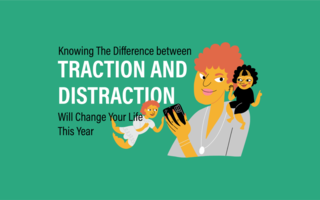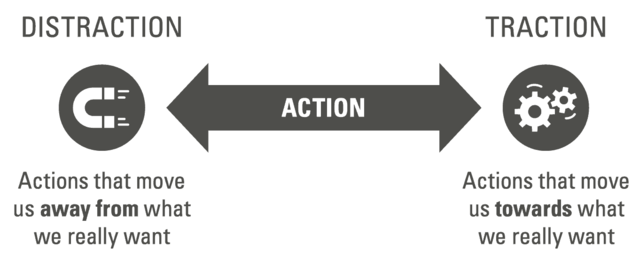Attention
What Is the Opposite of “Distraction?”
Knowing the difference between traction and distraction will change your life.
Posted February 9, 2022 Reviewed by Davia Sills
Key points
- It's easier to understand what distraction is if you know what it isn't.
- A distraction pulls you away from what you wish to accomplish, whereas a "traction" pushes you toward your goal.
- Deliberately scheduling your day helps you do what you intend to do.

In my research and consulting work, I’ve heard countless people tell me how difficult it is to manage their time.
Yet, when I ask them what they got distracted from—that is, what they planned to do with any given moment in time—they have trouble answering the question.
What is a “distraction” anyway? The best way to understand a distraction is to know what it is not. What is the opposite of distraction? It’s not “focus.”
The opposite of distraction is traction.
A distraction is something we do that moves us away from what we really want. Traction is an action that moves us towards what we really want. The difference seems obvious, but distraction has a sneaky way of tricking us.

At any given moment, it’s hard to tell whether we are moving towards or away from the very things we need to accomplish in our day. Checking your work email may feel productive at the moment, but when you really need to focus your attention on a big project, you are bound to regret the time you wasted cleaning out your inbox.
The difference between traction and distraction is forethought.
Any action can be either a distraction or traction, depending on what you intend to do with your time.
There’s nothing wrong with scrolling through your Facebook feed, watching YouTube videos, or playing a video game, as long as that’s what you intend to do. Taking a break can be good for you. It’s when you do things unintentionally that you get into trouble.
When I ask clients to show me their calendar so I can see what they intend to do, instead of a timeboxed calendar reflecting their values and priorities, they often show me schedules full of white space. They don’t keep a detailed calendar and, as a result, get thrown off-track by the whims of family members, colleagues, and friends.
They have prestigious jobs yet leave themselves unguarded against their most valuable asset—their time. What I observe when my clients start using a schedule maker is that they greatly reduce the number of distractions that take them off-track and start improving how they spend their time. As a result, they become more productive and satisfied—both at work and at home.
A schedule maker is a tool for building a weekly template for how you intend to spend your time. With a weekly template in hand, you’ll always know the difference between traction and distraction.
If you find yourself doing what you planned, that’s traction. Anything else is a distraction. Thankfully, there are free online schedule maker tools, like this one I whipped up, to help you build a detailed calendar in minutes.
If you take away just one thing, remember this: You can’t call something a distraction unless you know what it is distracting you from.
If you don’t schedule your day, you can’t possibly know the difference between what you intended to do and what was a distraction.


